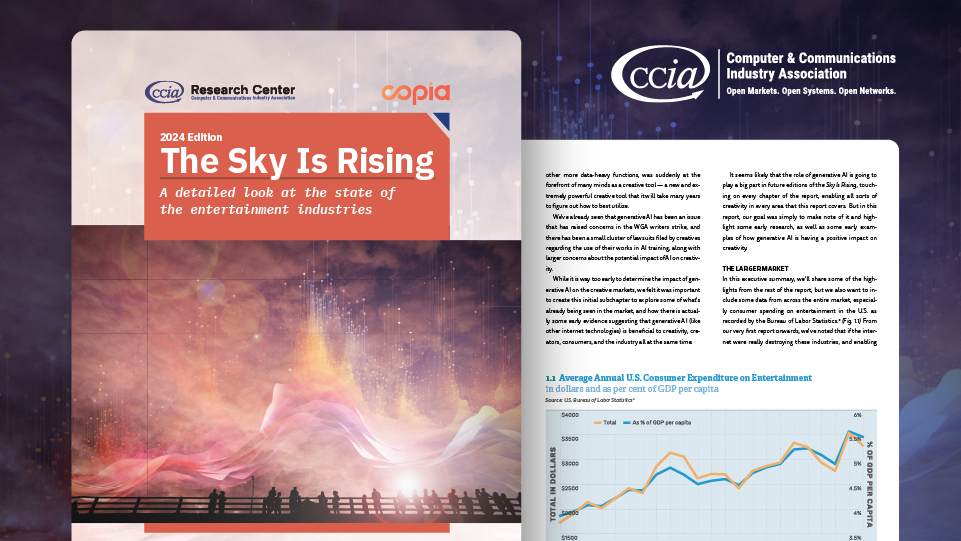How the Internet Promotes Creativity in the Television Industry

At the roundtables convened by the Copyright Office last month to discuss the notice and takedown provisions of the Digital Millennium Copyright Act, the representatives of the copyright industries conceded that digital networks have facilitated the creation and distribution of content. However, they stressed that this material has largely been amateur user generated content, not professional quality content. They argued that for professional artists, the Internet has been a net negative, with the lost revenue from rampant infringement greatly exceeding any savings from lower production and distribution costs.
The explosion of scripted television programming over the past few years proves this narrative false. Between 2009 and 2015, the number of scripted television shows nearly doubled, from just over 200 to 400. Much of this growth is attributable to the emergence of the “Big Three” streaming services: Netflix, Amazon, and Hulu. Netflix alone will spend $5 billion to produce 600 hours of original television programming. According to a lengthy article by Josef Adalian and Maria Elena Fernandez, “this dramatic surge in TV production has touched nearly every aspect of the industry,” including increasing demand for screenwriters, actors, production facilities, and crews.
This new generation of television programming operates under a new business model, which has created winners and losers. In the past, TV show creators, referred to as “showrunners,” and their film studio partners, would try to make a hit series which would run for six or seven seasons with 22 episodes per season. Such a show would generate enormous profits for the showrunners (and the studios) when reruns of the series were sold in syndication. The actors who were fortunate enough to be cast on a hit show, including character actors with small roles, would also benefit from this aftermarket, as would the writers.
According to Adalian and Fernandez, the syndication market encouraged the creation of “easily digestible procedural dramas with self-contained story lines.” In other words, a creative wasteland.
The streaming services have disrupted the syndication model. Unlike the broadcast networks, which in essence just leased a series from the showrunner for its first run, the streaming services (much like the premium cable channels HBO and Showtime before them) want to maintain control over the series in perpetuity to attract subscribers. They invest twice as much producing each episode, but they then own the rights to the series. The showrunner, the cast, and the writers receive a substantial guaranteed upfront payment, at the expense of the enormous backend potential of a hit show in syndication.
The streaming technology allows viewers to watch episodes of the series in sequence at their leisure, which in turn permits the creation of longer story arcs. With the higher per cost per episode, and the absence of syndication profits, the streaming service has less incentive to create long-running series. These various factors have converged to cause what Adalian and Fernandez call “a great leap forward in storytelling and production values” appreciated by critics, audiences, and artists alike. Top movie stars are more willing to appear in these innovative, well-paying, better scripted, short duration series than in traditional TV series.
Adalian and Fernandez observe that the current era of what they call “Peak TV,” with its “400-plus shows and evolving array of platforms, is an increasingly promising time for beginning and mid-level writers who are finding it easier than ever to land staff jobs.” At the same time, the shorter seasons means that the writers are earning less money than they would have had they “hit the big bonanza at the end of [the syndication] rainbow.” Nonetheless, writers enjoy the unprecedented creative freedom afforded by the streaming networks and the cable channels following their lead.
The television industry’s enormous demand for crews, equipment, and soundstages is so great that it exceeds U.S. production capacity. Accordingly, almost 50 of the 400 television shows are being filmed in Vancouver, which is known in the industry as “Hollywood North.”
Some industry participants worry that the surge in television production is a bubble that might burst. But among the various possible threats to this new golden era of television, Adalian and Fernandez make no mention whatsoever of copyright infringement. This suggests that the concerns raised in the Section 512 roundtables about the impact of the Internet on professional quality content have little validity, at least with respect to audiovisual works.








